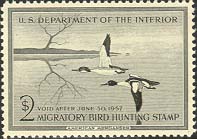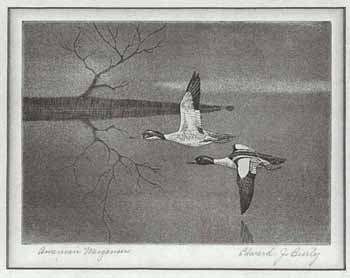

Back to RW23 Back to the Federal Index Home
A LITTLE HISTORY ON THE 23RD (1956-57) DUCK STAMP ARTIST


Edward J. Bierly was born in 1920, in Buffalo, New York, and was the last of the three children of Raymond Bierly, a detective in the Buffalo Police Department. His mother soon found an advantage of having a child with such a diligent attitude toward his artwork. By supplying a large sheet of white wrapping paper and a fat lead pencil, she was able to leave little Eddie alone so that she could go shopping, confident that he wouldn't budge until animals, airplanes, and battleships filled all the white space. Edward knew he wanted to be an artist by the time he was five years old.
His artistic talent was often called upon in his early years at Public School #67. Each holiday he would string Santa and eight prancing reindeer across the blackboard in vividly colored chalk, or create Easter bunnies, turkeys, or pumpkins, depending on the time of year.
Mr. Bierly worked for a short time as a surveyor after he graduated from high school in order to make enough money to attend Pratt Institute. He spent only six months at Pratt before he was drafted into the armed services for World War II. He was in camouflage work most of the time. He spent four years in the Army - tow of them in Europe. when he was discharged as a first lieutenant in early 1946, he went to the University of Buffalo. He received his Bachelor of Fine Arts degree from that school in 1949.
In the summer of 1949, he married a girl whom he had known since she was eight years old, Edith Brock. The couple left to spend their honeymoon and then to settle in Florida. But the Bierly's soon became restless at the lack of opportunities for artists there at the time. They packed their worldly belongings into a one-wheeled trailer and set out for New York City. Within three miles of their destination, the trailer collapsed.
Mr. Bierly had just started to make new beginnings in New York when, once again, the Army needed his service. He was recalled as a reserve officer for 17 months during the Korean War.
There were three Bierlys at the time of his discharge, and because of his new responsibilities, Mr. Bierly began to work as a civilian employee in camouflage research at Fort Belvoir. In 1955, while he was still there, he submitted his painting of American Merganser, which was used for the 1956-57 Duck Stamp design.
That same year he joined the National Park Service and worked as a designer of natural history and historical exhibits in new visitor centers. At this time, and even during his time at Fort Belvoir, he was doing free-lance wildlife artwork for various state and national wildlife publications and was illustrating books.
-------------------------THE ART-------------------------
American Mergansers was done in gouache. A steel-faced aquatint etching
print was hand pulled using ivory finish paper and black ink. The prints were hand
signed in pencil but not numbered. The print image size is 5"x7".
-------------------------THE STAMP-------------------------
American Mergansers...Engraved by the Federal Bureau of Engraving from the original
artwork. Printed in blue-black ink. The stamp sold for two
dollars. Postal records show 2,332,014 stamps sold. First day of sale was July
1, 1956.
Most of the information contained above is from the book Federal Duck Stamp Story, Fifty Years of Excellence, by Laurence F. Jonson; Alexander & Co. It is used here with permission from the author. For more information on this book, please click here.